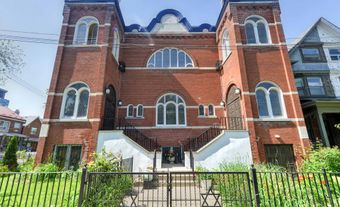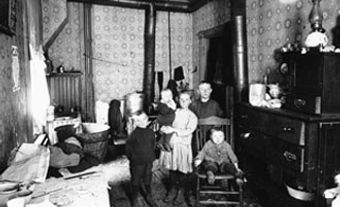Besha (Bessie) Starkman (Perri), organized crime boss (born 14 April 1889 or 21 June 1890 in Poland; died 13 August 1930 in Hamilton, ON). During the Prohibition era she became known as Canada’s first high-profile female crime boss. With her common-law spouse, mobster Rocco Perri, she ran a bootlegging and drug-smuggling enterprise. Starkman was gunned down in the garage of her home and her murderers were never caught. Her funeral was one of the largest ever seen in Hamilton.

Photo taken c. 1930.
Early Life
There is some uncertainty about Besha Starkman’s birthdate. According to some sources, she was born in Poland on 14 April 1889, but her tombstone says 21 June 1890. She arrived in Canada with her parents, Shimon and Gello Starkman, around 1900. They lived in the working-class Ward neighbourhood of downtown Toronto, where many newcomers to the city settled. She may have worked as a seamstress for the Eaton’s department store in her youth.
Marriage
At age 18, Bessie, as she was known, married Harry Tobsen (also recorded as Toben or Tobin), a driver at a bakery. The couple had two daughters, Gertrude and Lilly (Leah). In 1912, they took in a boarder named Rocco Perri who rented a room in their home. He was an immigrant from Calabria, Italy. Starkman and Perri had a romance shortly after, and she left her husband, children and Jewish faith for him. The common-law couple initially moved to St. Catharines, Ontario, where Perri had a job on a project to expand the Welland Canal.
By 1916, they were living in Hamilton. Perri worked briefly as a travelling salesman for the Superior Macaroni Company. The couple went on to open a small grocery store in a Jewish-Italian immigrant neighbourhood of the city.
Career with the Perri Mob
Bessie Starkman first became known to police when she was charged with “keeping a disorderly house.” She was accused of running a brothel, a place where prostitution takes place. Her defence was that she didn’t know what her female boarder was doing, but she was convicted.
In 1916, the Ontario Temperance Act came into effect. It made possession of liquor and beer outside the home illegal and led to the closure of bars and liquor stores. Starkman and Perri saw that they could make much more money from bootlegging — the illegal sale of alcohol — than running a grocery store. Perri became known as “The King of the Bootleggers” during the Prohibition years. He ignored the rule that barred women from the mob, and Starkman became the driving force behind the operation.
She became known by many as Canada’s first prominent female organized crime boss. Starkman negotiated and placed orders with liquor and beer suppliers, laundered money, looked after the payroll and made deals with other gangs. The Perri gang operated in Kitchener, Toronto, Windsor, Hamilton and Niagara. It also ran bootleg liquor to the United States, primarily to Detroit, Chicago and New York State.
By 1920, the couple had moved into a large home at 166 Bay Street South in Hamilton. They had a lavish lifestyle that included everything from diamonds to expensive cars. Things went well for Starkman and Perri until March 1927, when they appeared before the federal Royal Commission on Customs and Excise, which investigated liquor smuggling (see also Customs and Excise). She denied any connections to bootlegging. Nevertheless, she and Perri were charged with perjury. While the charges against Starkman were dropped, Perri pleaded guilty and was sentenced to six months in a reformatory.
The end of Prohibition in Ontario in 1927 forced the Perri mob to look for new sources of income, like the illegal drug business. In June 1929, the Royal Canadian Mounted Police held Starkman during a drug raid at a house in Toronto, but released her due to a lack of evidence.
Death
Embed from Getty ImagesShortly before midnight on 13 August 1930, the couple returned home from an event. When Bessie Starkman stepped from her car in the garage, she was greeted with gunfire from two men with shotguns. A neighbour walking his dog heard Perri yelling that Bessie had been shot. Reports suggested that two men shot Starkman and another drove the getaway car. She died instantly.
An Ontario Provincial Police investigation could not find a clear motive for her murder. Her killers were never found. However, several theories emerged: she had been shot by angry members of the Perri gang, her husband was involved or she had refused to pay gangsters from Rochester, New York, for a drug deal.

The garage of the Perri home where Bessie Starkman was shot.
Her funeral on 17 August 1930 was one of the biggest in Hamilton’s history. A report in the Toronto Star estimated that more than 20,000 people lined the streets and crowded the Ohev Zedek Cemetery where she was buried. It was said there were so many cars in the funeral procession, that when the first car reached the cemetery, the last car hadn’t left Starkman’s Bay Street house 6 km away.
Because of her controversial life and common-law relationship with a non-Jew, a local rabbi refused to bury her. Instead, a visiting rabbi who had once lived in the city was brought in to conduct the funeral service. There was no cantor (see Jewish Music and Musicians) and the rabbi did not deliver a eulogy. Starkman was assigned a cemetery plot by a fence, as far away as possible from the other burials. (See also Funeral Practices in Canada.)
The name Bessie Starkman-Perri was originally on Starkman’s monument. However, the Perri name no longer appears.
Starkman in Pop Culture
Many years after her murder, Bessie Starkman remains a source of fascination. Her life was recounted in the play Bootlegger’s Wife, staged several times during Hamilton’s Fringe Festival in 2014. She has been featured in walking tours on “Hamilton’s Dark History.” In 2019, a character called Bessie Starkman, based on the real person, appeared in a few episodes of the CBC-TV series Frankie Drake Mysteries. The show, set in the 1920s, follows Toronto’s only female private detective, who takes on cases the police will not. The Starkman character appears as a mob boss running an illegal casino in Toronto. In one episode, she agrees to work with Frankie Drake on a case.

 Share on Facebook
Share on Facebook Share on X
Share on X Share by Email
Share by Email Share on Google Classroom
Share on Google Classroom










